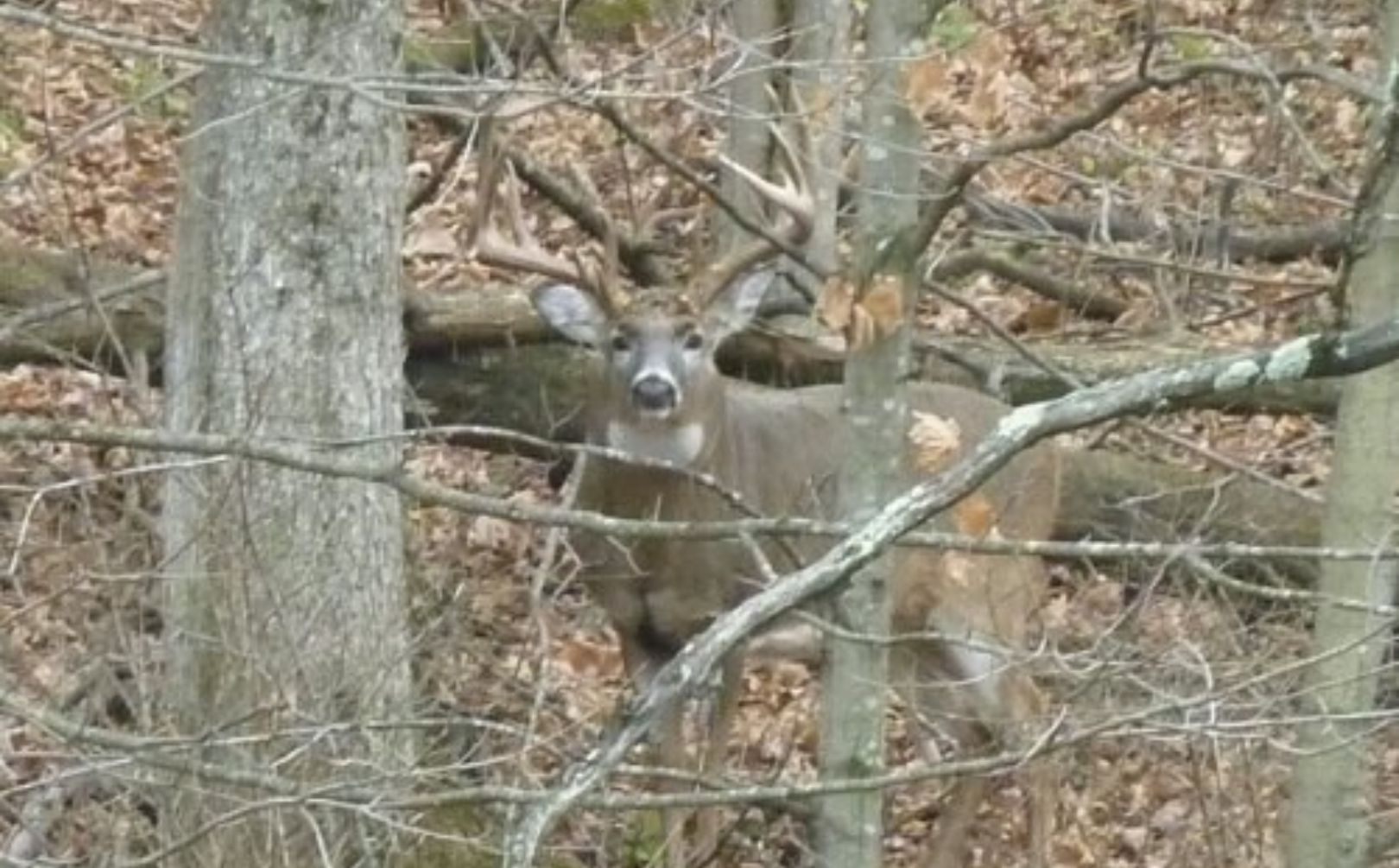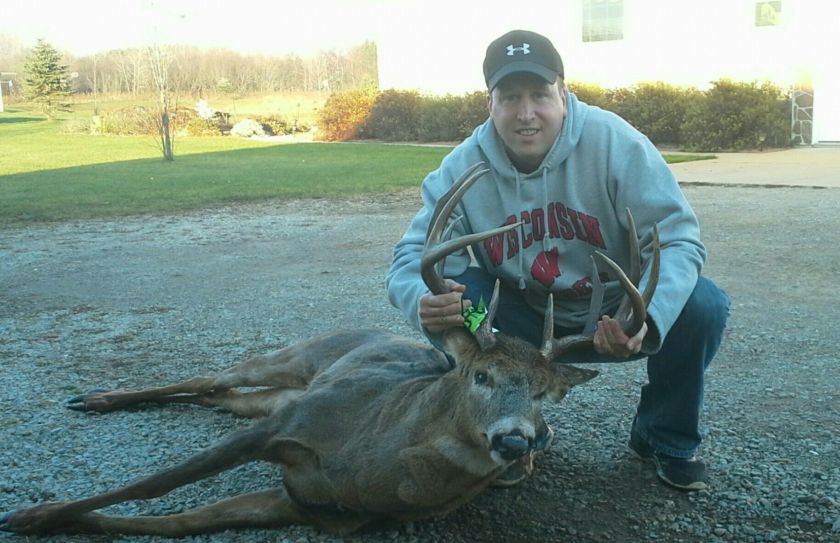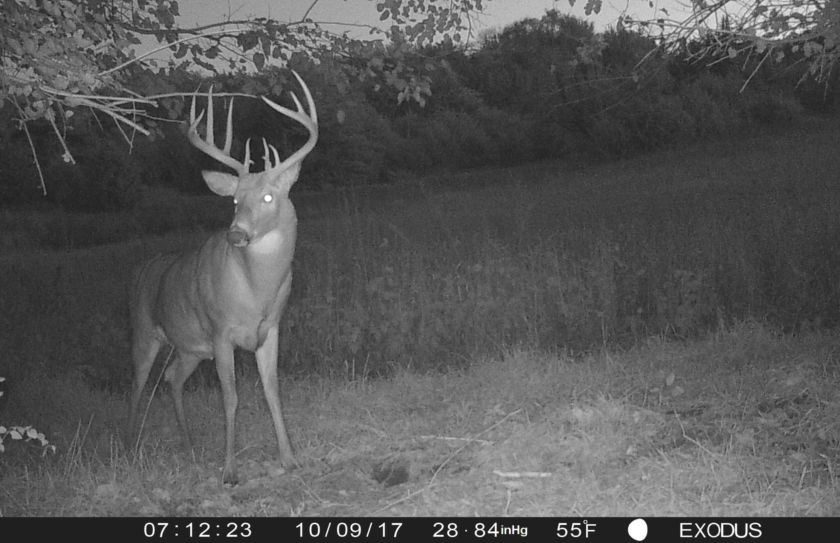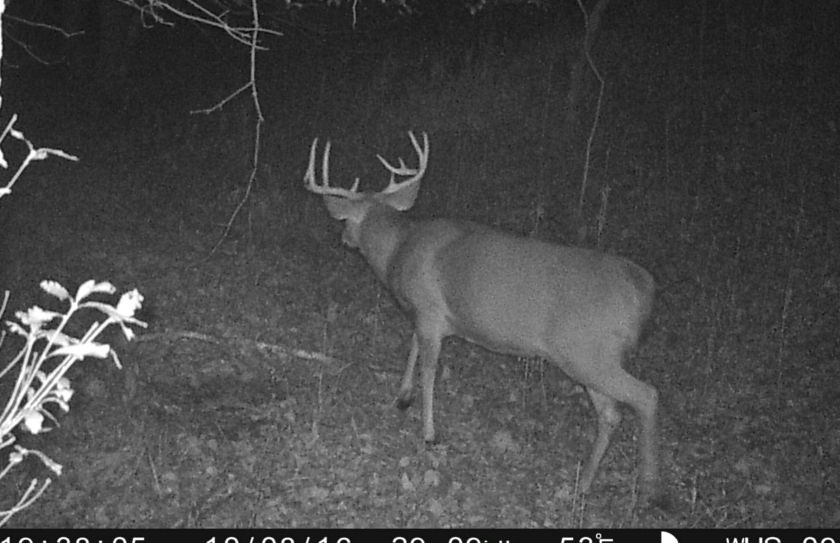
Can you realistically manage the complete life of a mature buck on a 40 acre parcel? No. But you can definitely manage for them! Although 40 acres is truly too small to attract, hold, and effectively manage a mature buck's entire world, that does not mean that you can't have the opportunity to shoot one every year. However, in order to accomplish that you have to follow some very important principles in mature buck management for small properties and the smaller the property, the more critical and unforgiving those principles become. Balance In Food, cover, Yearly Nutrition, effective sanctuary use, Separation of Buck and Doe Bedding, and Effective Hunting Stratagies are the five proven principles I have found that need to be appropriately applied in order to attain your small parcel's maximum buck age structure potential.
*Small parcels can have big potential! Maximizing the space you have with strategic improvements can turn a micro parcel into a mature buck magnet. For the full article, check out, "Big Property Potential on Micro Deer Hunting Parcels."
Food vs. Cover
This is a great discussion for your deer camp table, but what is more important, food or cover? That is an easy answer, right? Well, you may find that depending upon where you hunt, the answer couldnt be more definitively opposite than someone elses. Why? Because every property is different, every region is different, and every different habitat type carries different requirements with the extremities being either agricultural or wilderness settings.
One of my favorite and sometimes easiest parcels to manage is located in a limited cover open agricultural setting. To paint a picture, think of sections of land filled with cash crop rotations of corn and soybeans, scattered with lush alfalfa fields. An occasional river snakes its way through the fertile valleys and lonely woodlots to break the monotony of miles and miles of food. If you happen to own 20 acres of cover in an area like this, count your blessings, because with simply a chainsaw and a few gallons of 40:1 fuel you have the ability to create a literal magnet of wildlife bounty. Sure, you could use a food plot or two but in this type of setting COVER, not food is going to be your ticket of attraction to the local deer herd.
So cover is the answer to any property, all the time, right? Well, this is where it gets a little tricky but the quick answer is "No". Believe it or not, there are areas where cover, even quality cover is overly abundant. In many northern wilderness settings or even the expansive brush country of Texas, a buck has his choice of many potential bedding areas. You can create all the bedding areas you want in a location like this and what youll be left with is just a few more deer beds to add to the total bedding areas that already number several times more than local deer densities. However, a powerful ingredient can be used by the experienced land manager in these areas in the form of a quality food source. Compared to the expansive open agricultural setting a much higher percentage of quality food source should be used on a small property in most wilderness settings to attain the appropriate balance. If you provide the correct amount of quality food sources, then you can attempt to build your bedding areas to help you hold, expand, and harvest your parcel's buck population. In order to produce that optimum buck population in a wilderness setting, it often starts with food, not cover.
How can you tell when you don't have enough of either food or cover? Let the deer tell you because in the end, they will either stay or leave, and its up to the savvy small property owner to recognize the needs of the local deer herd and to adjust to the appropriate level of balance for their particular property.

If you enjoy advanced whitetail strategies, you'll love my Whitetails By Design Book Trilogy!
Nutritional Balance
Dessert or desert, what does your property yield during the most critical times of the year? There seems to be a growing trend of what I like to refer to as "perennial over-abundance". Perennials are an incredible tool! For example, on my Upper Peninsula of MI property I maintained a perennial base including clover and chicory of between 10 and 20%, and those forages played vital roles in the yearly nutrition of the local deer herd. But, both of those forages also have their limitations. A blend of both clover and chicory may provide excellent nutrition from early May to mid October in your region, while adequately covering over five full months of nutritional need. Five full months is great, but keep in mind that this also a time of a literal explosion of native food sources. In the extremity of most northerly settings this explosion of native habitat supplies several times more than the local deer densities require and it is at this time when local deer herds are in optimum health.
That leaves you with the other 6-7 months, and those months can be some of the leanest, most difficult times for whitetails within the region. Often in the north, with snow levels up to 30-40 throughout the entire winter food plots are ineffective for a few weeks, sometimes even a few months. However, that still leaves at least several weeks pre and post winter even in the most northerly settings to attempt to provide nutrition, and this cannot be accomplished with perennial forages alone. Forages such as oats, rye, brassicas, peas, soybeans, and even corn can all be used to offset the deficiencies of the perennials. Those cool season annuals can also be used in various combinations to provide adequate forage for the most critical months of the year, including not only pre and post winter, but sometimes during winter itself.
Ask yourself what you think is more important. Should you attempt to provide great forage for the year at a time when the local deer herd and habitat is at its best, or to provide adequate forage for the other of the year at a time when the local deer herd and habitat is at its worst? That discussion can be applied from northern MI to southern TX even if the worst seasons of the year are the exact opposite! As in the case of food vs. cover the answer can be as simple as watching the local deer herd. For example, if the bulk of the deer herd leaves your property because they dont have anything to eat during hunting season and your neighbors shoot them it may be time to search for nutritional balance. At the same time, in northern settings if your property is devoid of deer for the few weeks prior to spring green-up you are missing a golden opportunity to provide post winter nutrition for the local deer herd. By observing when the deer eat and when they dont eat on your property, you will be able to adjust accordingly to make sure you are attaining the balance necessary to achieve the most attractive parcel within the area during the most critical times of the year. You will also find that attracting deer has a lot to do with food, but where a deer beds during the daytime can not be ignored.
Daytime Sanctuaries
This is such a well-known tool that can be destroyed in an instant. Hunters often ask, What percentage of sanctuary do I need? When answering this question I like to begin by defining what possible reasons you need to use the property. Accessing food plots, stand locations, minerals stations, feeders, camera sites may all be reasons to travel on your property. But, other than accessing specific locations using specific travel routes, the bulk of your property is left untouched and what remains can effectively be called your sanctuary. On a very small parcel of 10 to 20 acres it may be appropriate that just about all of your property is a sanctuary with the possible exception of a few scattered perimeter stand locations used to hunt deer as they enter or exit the property. Of course inner sanctuaries can be developed as daytime bedding areas and should be shielded and protected by the bulk of the surrounding sanctuary area but it takes much more than a label on a map and a few wacks with a chainsaw to develop a true sanctuary.
A true sanctuary will allow for the unmolested daytime bedding of the local deer herd, a deer herd that hopefully includes mature bucks. Mature bucks are reclusive; they are bold, strong, confident, yet extremely cautious and wary. It is often a mature buck will spend the majority of his daytime bedding, in one lonely bed. Buck beds I have become familiar with have had a few things in common. Most have elevation, good visual in at least one direction, nearby escape cover, effective screening cover, and all have been dry and clean from woody debris. You can build an attractive bed but if you do not offer security to the deer within that bed your sanctuary is ineffective.
Noise and scent are often the two blunders that diminish the use of dedicated sanctuary area. If you treat your entire property as a sanctuary and if you use your property with the full awareness that one mistake can cost you the season, you will have developed the proper mindset for what it takes to attract, hold, and harvest mature bucks on a small parcel. Throughout hunting season, even pre-season, you can begin to collect mature bucks as your neighbors carelessly relocate them from their daytime bedding areas, or you can turn your property into a virtual bumper of mature buck activity. A mature buck can wander miles under the cover of darkness but during the daylight hours his activities the majority of the year can be limited to just a few acres. It is that daytime bedding activity that you as a small property owner have the most influence over.
What is the appropriate percentage of sanctuary? All of it! with the exception of trails, hunting plots, and stand locations and thats how critical the use of a small parcel is to achieving your potential success. On a parcel of 40 acres or less it is tough to achieve more than 60% as sanctuary because of your need to access the parcel for hunting. However, on larger parcel a sanctuary encompassion 80% or more is possible! As you continue your management efforts you will find that its not only the overall percentage of cover or food that lead to your dream, but instead how the necessities of your property are separated to allow for your propertys ultimate level of separation of the sexes.
Separation of the Sexes
You have all probably seen the dominating characteristics of a mature doe. Charging, boxing, and aggressive posturing are enough to influence the most stubborn of subordinates. I've even watched a dominant doe and her fawn selfishly protect a small food plot for an entire season. Most of the time it only took that look (guys, you know the look!) and a potential small plot browser was soon cutting the corner to friendlier pastures. This situation is no different with bucks of all ages as well if your property necessities are not effectively scattered.
What are the property necessities? Well, segregation of the sexes all hinges back to the food vs. cover discussion. I can use my property in the U.P. of Michigan as an example, and maybe you can think back to your own experiences with the land you hunt. For the first few years I concentrated mainly on the large, centralized food plots, which have proven to be the foundations of food for the property. The first year my cameras were able to capture only 1 yearling buck the entire season. Within a few short years the 8 plots totaling 5 acres were becoming frequent hangouts to several bucks, including a few 2 year olds. But, it was not until the plot expansion was increased to 17 plots totaling over 8 acres that the explosion of bucks could be witnessed on the 120 acre parcel. By the end of the 2006 season a total of 17 different bucks were discovered by camera, including multiple 3 year olds, let alone 2 year olds..
As further evidence to the reclusive ness of the mature bucks on the property, most of the mature bucks inhabited only small portions of the property with one other buck at most, and in some cases were never caught by camera outside of the 40 acre area they called home.
I believe the property also become a very attractive setting for dispersing yearling bucks as well. Imagine the attitude of a dispersing yearling buck when he walks into a parcel ripe with quality food and cover, within an area that traditionally has poor food choices. A yearling buck disperses due to female social pressure, so when a young buck finds a parcel with scattered food sources, bedding areas and most importantly scattered mature does; that parcel will be a very attractive situation to potentially Stay within.
By understanding the balance of food and cover, and addressing the needs of the local deer herd in both size and number, your small property will be at its peak for attracting and holding a quality herd. On a very small wilderness property that balance may mean a large food plot or two and several scattered small plots to support multiple Lines of Deer Movement. But, on an open agricultural property your most critical need is most likely as many scattered quality bedding sites as possible located on the interior of your sanctuary.
It is the entire big picture of small property management that will lead to your propertys ultimate segregation of the sexes, including: the balance of food and cover, the balance of nutrition, and the effective use of sanctuaries. However, although you can create a superb environment for attraction, segregation, and overall use, your efforts can come to a screeching halt if strict small property hunting techniques are not carefully followed. In fact I have expereinced that no degree of "perfection" in your food or cover improvements is enough to overcome poor hunting methods.
Hunting Strategy
The #1 goal of the small property hunter should be to reach the end of the deer season without the deer knowing they are being hunted. Yes, it is impossible, but that is the approach you must take. Calling techniques, use of scents, decoys, deer drives, brush busting, scrape and rub hunting are all great topics of hunting strategy but mistake-free hunting is what is so critical on a small parcel because one mistake can cost you the season. I like to pay close attention to the 7 critical strategies of Mistake-Free Hunting, including: Access, stand location and variety, doe harvest, noise, scent, and downwind blockers. An entire book could be written on those 7 strategies, but ultimately whether it be harvesting does as unobtrusive as possible or keeping your hunting movements limited to non-food or bedding cover areas, a great amount of hunting strategy must be employed on small parcels to achieve consistent success. Do the deer know they are being hunted on your property? By pecking away at your property with conservative hunting efforts designed to maintain security your mistakes can be kept to a minimum and the local deer can have as little insight into your movements as possible. The way a small parcel is hunted is definitely the "lowest hole in the bucket" when it comes to advanced whitetail management strategies. There is no amount of perfection in plots, deer beds, water or travel corridor that can overcome sloppy hunting efforts.
Conclusion
Can you succeed on a small parcel? You sure can. However, mature buck management techniques have to be religiously followed because there is little room for error. It is an exciting time in the hunting and management of whitetails! As the various tools of management are explored and experienced, as knowledge is increased and applied into practice, the size of the parcel once thought to be needed to reveal consistent success is becoming surprisingly small. By pushing the envelope in the balance of food, cover, and nutrition, as well as in effective sanctuary use, separation of the sexes, and proven hunting strategy, your property can one-day experience its true mature buck potential.


